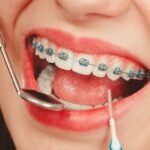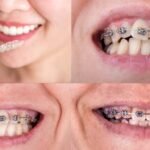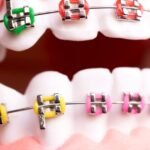When you ask someone about the hardest part of braces, they usually give the same answer, flossing.
Ask anyone what the hardest part about braces is, and they’ll usually give you the same answer, flossing. One study found that 31 percent of Americans floss their teeth when they don’t have braces. Flossing is a difficult task to remember every day. So when trying to floss with braces with traditional braces in the way, the task becomes even more difficult.
Flossing is an excellent part of good hygiene and becomes even more important when you have braces. Maintaining good hygiene during braces is extremely important to keep cavities and gum disease at bay.
Flossing with braces can seem difficult, but with the right technique, you can keep your teeth and gums healthy during your orthodontic treatment.
Table of Contents
Why is Flossing Important with Braces?
The question of why flossing is important must be bothering you too. Flossing actually helps you remove food particles that are stuck around your teeth and your braces, places that you can’t clean by brushing. In general, flossing doesn’t just remove plaque. Rather, it helps prevent cavities and gum disease and improves your hygiene. If left unchecked, plaque buildup can lead to tooth decay, bad breath, and gum disease. This can prolong your treatment or cause complications that will be difficult for you.
If someone has braces, the risk of developing gum disease and plaque increases dramatically. If you’ve spent a lot of money on braces to keep your teeth straight, wouldn’t you want your teeth to stay healthy and fit in the process?
Therefore, we will tell you the easiest and most effective ways to floss your teeth. Which will help you to floss your teeth properly.
What happens if you don’t floss with braces?
If you don’t floss with braces, food particles can collect between your teeth, causing a variety of dental problems such as cavities, gum disease, and bad breath. Anna, etc. Over time, this can result in swollen gums, bleeding, and certainly more severe gum disease that will prolong your dental treatment for a long time. If you ignore the floss, you may get permanent white spots or yellow spots on your teeth which can affect the beauty of your smile. Therefore, flossing is very important for the health of your teeth and the success of your dental treatment.
Why is Flossing with Braces Hard?
Flossing while wearing braces can be a difficult process because the wires and brackets can block direct access to the spaces between the teeth. You must have often noticed that while doing regular flossing, the floss gets stuck in the wires, which takes a lot of time. To avoid these problems, you will be happy to know that there are many flossing tools and techniques available in the market that make it not only easier but also much more effective.
What Tools Can Help You Floss with Braces?
Here are some flossing tools that can make the process easier
- Water Flossers
These appliances use a strong stream of water to remove food particles and plaque from between your teeth. Although these devices cannot replace traditional flossing, they still add a great deal to your oral hygiene.
- Orthodontic Floss Threaders
These are small, flexible threads that help you floss regularly under the wires of your braces, allowing you to floss more easily between your teeth.
- Waxed Floss
Waxed floss is less prone to shredding or getting stuck on your braces than unwaxed floss.
- Super Floss
Designed specifically for people with braces, super floss has stiffened ends that make it easier to thread under wires, and spongy sections to clean around brackets and between teeth.
- Interdental Brushes
Interdental brushes have small bristle tips that can fit between teeth and braces. It is especially useful for cleaning large gaps in teeth or around brackets.
How Do You Floss with a Floss Threader?
Here’s a step-by-step guide to using a floss threader for braces
- Thread the Floss
To use the floss threader, insert an 18-inch piece of floss into its loop.
- Position the Threader
Now gently slide the pointed end of the trimmer under your brace wire.
- Pull the Floss Through
In this step, you have to pull the floss thread until the floss threader is no longer needed.
- Floss Between Teeth
Use floss as part of your daily routine. Now gently slide the thread up and down between the teeth making a “C” shape around the base of each tooth.
- Move to the Next Tooth
Now the work is almost done and carefully pull out the floss, if necessary repeat it again and again and move on to the next tooth.
How Can You Floss with Super Floss?
Superfloss can be another great option for those who have braces. Superfloss consists of three different parts. A hard end for threading, a spongy middle section used for cleaning around the brackets, and a regular floss section between the teeth. Here’s how to use it
- Thread the Stiff End
To start, insert the stiff end of the super floss under the wire of your braces.
- Clean Around Brackets
In the second step, use the sponge part of the floss to clean around the brackets and wires.
- Floss Between Teeth
Insert the regular floss between your teeth just as you would with traditional floss.
- Repeat for Each Tooth
Repeat this process for each tooth and work around your mouth.
How Often Should You Floss with Braces?
Just like you would floss your regular teeth, you should floss at least once a day when you have braces. The best time to floss with braces is after you brush your teeth before bed. To ensure this, you should continue to remove stuck food particles from your teeth throughout the day so that they do not cause further problems.
What Mistakes Should You Avoid When Flossing with Braces?
Here are some common mistakes to avoid when flossing with braces:
- Skipping Days
Consistency is the key to success. Flossing with braces takes extra effort, but it’s important not to rush any day. If you want to avoid dental complications, floss regularly.
- Being Too Forceful
Never use excessive force when flossing as this can damage your wires, brackets or gums. Gently guide the floss between your teeth to avoid any injury.
- Not Using the Right Tools
When you have braces, standard floss isn’t enough. Make sure you’re using the right tools for your specific needs, whether it’s super floss or water floss.
- Neglecting the Gumline
Don’t limit flossing to just between your teeth, but make sure to do it under the gums as well. It not only helps prevent gum disease but also plaque buildup.
Can Flossing with Braces Cause Damage?
When flossing correctly, braces will not cause any damage. But if you are careless, you can break the wire or damage the brackets. Always be gentle and take as much time as possible to floss. If you ever accidentally break a wire or damage your braces, contact your Orthodontist immediately.
What Are the Benefits of Flossing Regularly with Braces?
Flossing regularly while wearing braces offers numerous benefits:
- Prevents Cavities
Flossing not only removes plaque but also prevents food particles from accumulating in the teeth, which can cause tooth decay and cavities.
- Prevents Gum Disease
It helps keep your gums healthy by preventing gingivitis and other gum diseases.
- Maintains Fresh Breath
Flossing up helps remove food particles stuck in the teeth that cause bad breath. It helps to strengthen your relationship with people.
- Protects Tooth Enamel
Regular flossing prevents the buildup of plaque, which can erode tooth enamel over time.
- Ensures Successful Orthodontic Treatment
When flossing, good oral hygiene helps the orthodontic treatment go more smoothly and reduces the risk of complications that can prolong the process.
What is the easiest way to floss with braces?
The easiest way to floss with braces is with threaded floss or orthodontic floss. These tools help guide the floss under the wires, making it easier to reach between the teeth. As an alternative to this, using an up-water floss head can be an effective and convenient option, as it can help clean between and around the teeth without the need for threading floss.
Conclusion
Flossing with braces may seem difficult at first, but with practice and the right tools, it will become a routine part of your daily oral hygiene. Whether you choose to use a floss threader, super floss, or a water flosser, what’s most important is that you stick to a consistent routine. Flossing every day will help keep your teeth and gums healthy, ensuring that your smile will be radiant once your braces come off.
FAQs
[sp_easyaccordion id=”1662″]







1 thought on “How to Floss with Braces? The Ultimate Guide”